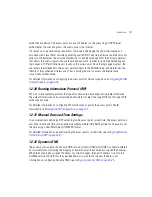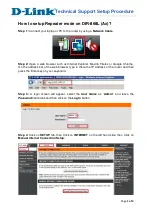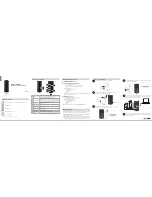
Motorola Solutions AP-7131N-FGR Access Point Product Reference Guide
1-26
1.3.4 Direct-Sequence Spread Spectrum
Spread spectrum (broadband) uses a narrowband signal to spread the transmission over a segment
of the radio frequency band or spectrum. Direct-sequence is a spread spectrum technique where the
transmitted signal is spread over a particular frequency range. The access point uses
Direct-Sequence Spread Spectrum (DSSS)
for radio communication.
Direct-sequence systems communicate by continuously transmitting a redundant pattern of bits
called a
chipping sequence.
Each bit of transmitted data is mapped into chips by the access point and
rearranged into a pseudorandom spreading code to form the chipping sequence. The chipping
sequence is combined with a transmitted data stream to produce the output signal.
MUs receiving a direct-sequence transmission use the spreading code to map the chips within the
chipping sequence back into bits to recreate the original data transmitted by the access point.
Intercepting and decoding a direct-sequence transmission requires a predefined algorithm to
associate the spreading code used by the transmitting access point to the receiving MU. This
algorithm is established by IEEE 802.11b specifications. The bit redundancy within the chipping
sequence enables the receiving MU to recreate the original data pattern, even if bits in the chipping
sequence are corrupted by interference.
The ratio of chips per bit is called the
spreading ratio
. A high spreading ratio increases the resistance
of the signal to interference. A low spreading ratio increases the bandwidth available to the user. The
access point uses different modulation schemes to encode more bits per chip at higher data rates.
1.3.5 MU Association Process
An access point recognizes MUs as they begin the association process. An access point keeps a list
of the MUs it services. MUs associate with an access point based on the following conditions:
•
Signal strength between the and MU
•
Number of MUs currently associated with the access point
•
MUs encryption and authentication capabilities
•
MUs supported data rate
MUs perform pre-emptive roaming by intermittently scanning for ’s and associating with the best
available access point. Before roaming and associating, MUs perform full or partial scans to collect
statistics and determine the direct-sequence channel used by the access point.
Scanning is a periodic process where the MU sends out probe messages on all channels defined by
the country code. The statistics enable an MU to reassociate by synchronizing its channel to the
access point. The MU continues communicating with that until it needs to switch cells or roam.
Содержание P-7131N-FGR
Страница 1: ...Motorola Solutions AP 7131N FGR Product Reference Guide M ...
Страница 3: ...AP 7131N FGR Access Point Product Reference Guide ...
Страница 4: ......
Страница 14: ...Motorola Solutions AP 7131N FGR Access Point Product Reference Guide 10 ...
Страница 46: ...Motorola Solutions AP 7131N FGR Access Point Product Reference Guide 1 30 ...
Страница 57: ...Hardware Installation 2 11 ...
Страница 70: ...Motorola Solutions AP 7131N FGR Access Point Product Reference Guide 2 24 ...
Страница 90: ...Motorola Solutions AP 7131N FGR Access Point Product Reference Guide 3 20 ...
Страница 224: ...Motorola Solutions AP 7131N FGR Access Point Product Reference Guide 5 78 ...
Страница 296: ...Motorola Solutions AP 7131N FGR Access Point Product Reference Guide 6 72 ...
Страница 639: ...Configuring Mesh Networking 9 23 4 Enable base bridge functionality on the 802 11a n radio Radio 2 ...
Страница 692: ...Motorola Solutions AP 7131N FGR Access Point Product Reference Guide B 10 ...
Страница 699: ......
















































